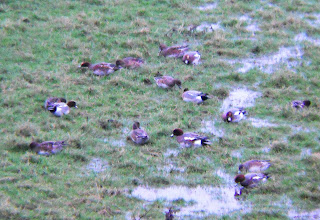Monday
With Beth back in this week, all three of us spent the morning in the office, helping with odd jobs that need doing as it's the last week before Christmas!
We spent the afternoon in Welsh learning about the weather and enjoying mince pies and Cadbury's Roses!
"Mae hi'n oer heddiw" - It's cold today.
"Gobeithio bydd hi'n bwrw eira!" - I hope it snows!
"Mae hi'n oer heddiw" - It's cold today.
"Gobeithio bydd hi'n bwrw eira!" - I hope it snows!
Tuesday
Today the three of us spent the day at Silent Valley repairing a section of the 'Exclusion Zone' fence line. We began by unpinning the old wire from the fence posts and pulling it back out of the way. We then used a bar to create a hole in the ground deep enough to put a fence post in. Using a drivall we drove in the post - constanly checking it was straight using a large spirit level. We put in a bottom wire at ground level to prevent stock getting under the fence before stapling the main fencing wire across the posts. After this we added two top wires, tidied up any sharp ends, and tightened lengths of barbed wire that had come loose on the adjoinging length of fence.
 |
| Sally about to start unpinning the fence. |
 |
| Beth stapling the stock fence to one of the older posts. |
Wednesday
Today the three of us were joined by Alaw (GWT's Grazing Trainee) and two long term volunteers for the first day of a trimmer and brushcutter course!
We spent the morning going through health and safety and risk assessments, before moving on to look at the components of a trimmer and how to maintain it. Unfortunately it rained heavily for the entire day which meant that, even geared up in waterpoofs and safety gear, we only got to use the trimmers for a short time in the afternoon.
 |
| Beth doing brushcutter maintenance by filing down the chipped blade. |
 |
| Alaw filing a brushcutter blade. |
Thursday
The second and final day of our trimmer and brushcutter course......and yet another lovely day of rain!
Today we moved on to the brushcutters and spent the morning learning about the different heads that can be used with these machines and which heads are used to cut through various vegetation types. By the afternoon the rain had eased off enough for us to get out and use the brushcutters without getting soaked to the skin!
 |
| With guidance from the instructor, Beth starts up a brushcutter! |
At the end of the day we recapped on all the safety and maintenance aspects and finished the required paperwork before being given the great news that we had all passed!!
TTTTTTTTTTTTTTTTTTTTTTTTTTTTTTTTTTTTTT
T Nadolig Llawen a Blwyddyn Newydd Dda! T
T Merry Christmas and a Happy New Year! T


.JPG)





























